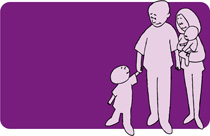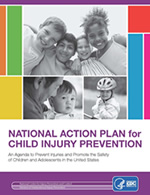Home & Recreational Safety – Press Room
Injury: The #1 Killer of Children
(Posted 04/16/2012)
 Child injuries are preventable, yet more than 9,000 children died from injuries in the US in 2009. Car crashes, suffocation, drowning, poisoning, fires, and falls are some of the most common ways children are hurt or killed. More can be done to keep our children safe.
Child injuries are preventable, yet more than 9,000 children died from injuries in the US in 2009. Car crashes, suffocation, drowning, poisoning, fires, and falls are some of the most common ways children are hurt or killed. More can be done to keep our children safe.
Vital Signs: Child Injury
To help highlight the issue, the latest edition of CDC Vital Signs discusses the serious problem of child injury in the United States. It also highlights steps that everyone—including parents, states and communities, health care systems, employers, and more—can take to help save young lives.
 National Action Plan for Child Injury Prevention
National Action Plan for Child Injury Prevention
CDC is committed to preventing child injury by supporting solutions that will save lives and help children live to their fullest potential. The National Action Plan for Child Injury Prevention was developed by CDC and more than 60 stakeholders to spark action across the nation. The National Action Plan’s overall goals are to:
- Raise awareness about the problem of child injury and the effects on our nation.
- Highlight prevention solutions by uniting stakeholders around a common set of goals and strategies.
- Mobilize action on a national, coordinated effort to reduce child injury.
Learn more
Members of the News Media
For more information call CDC Injury Center Media Relations at 770-488-4902.
General Public
Inquiries from the general public are handled by CDC-INFO at 800-CDC-INFO or 800-232-4636.
Prevent Drownings and Water-Related Injuries
(Posted 05/25/2010)
 When most of us are enjoying time at the pool or beach, injuries aren’t the first thing on our minds. Yet, three children die every day as a result of drowning. And for young children ages 1 to 4, drownings are the leading cause of injury death. Thankfully, parents can play a key role in protecting the children they love from drowning.
When most of us are enjoying time at the pool or beach, injuries aren’t the first thing on our minds. Yet, three children die every day as a result of drowning. And for young children ages 1 to 4, drownings are the leading cause of injury death. Thankfully, parents can play a key role in protecting the children they love from drowning.
Fence it off. Install a four-sided isolation fence, with self-closing and self-latching gates, around backyard swimming pools. Pool fences should completely separate the house and play area from the pool.
Make life jackets a "must." Make sure kids wear life jackets in and around natural bodies of water, such as lakes or the ocean, even if they know how to swim.
Learn CPR. Learn cardiopulmonary resuscitation (CPR) and get recertified every two years. CPR can help a child stay alive with little or no brain damage.
Be on the lookout. Supervise young children at all times around bathtubs, swimming pools, and natural bodies of water. Adults watching kids near water should avoid distracting activities like playing cards, reading books, or talking on the phone.
Learn More
Members of the News Media
For more information call CDC Injury Center Media Relations at 770-488-4902.
General Public
Inquiries from the general public are handled by CDC-INFO at 800-CDC-INFO or 800-232-4636.
Fire Safety and Prevention
(Posted 10/2009)
A residential fire claims a life every three hours, making fires the 3rd leading cause of fatal home injury in the United States. Fire deaths and injuries are preventable, and that is why the CDC’s Injury Center partnered with the U.S. Fire Administration (USFA) and the Consumer Product Service Commission (CPSC) to develop a consolidated, powerful voice in fire safety and prevention. Please access this vital information, including life-saving tips and tools at www.FireSafety.gov, an information resource for eliminating fire deaths.
 One of the newest tools on the site is the Fire Spokesperson’s Pocket Media Guide. This guide is designed to help Public Information Officers (PIOs) maximize the impact of fire safety messages in interviews with local and national news media in the days and weeks following a residential fire in their communities. 2008 statistics report fire departments responding to 403,000 home fires across the country, in which the lives of 2,755 people were claimed and another 13,560 were injured. These tragic figures represent the many “teachable moments”, when communities are most poised to hear life-saving fire prevention tips and act on them to secure their homes and save lives.
One of the newest tools on the site is the Fire Spokesperson’s Pocket Media Guide. This guide is designed to help Public Information Officers (PIOs) maximize the impact of fire safety messages in interviews with local and national news media in the days and weeks following a residential fire in their communities. 2008 statistics report fire departments responding to 403,000 home fires across the country, in which the lives of 2,755 people were claimed and another 13,560 were injured. These tragic figures represent the many “teachable moments”, when communities are most poised to hear life-saving fire prevention tips and act on them to secure their homes and save lives.
Members of the News Media
For more information call CDC Injury Center Media Relations at 770-488-4902.
General Public
Inquiries from the general public are handled by CDC-INFO at 800-CDC-INFO or 800-232-4636.
Get email updates
To receive email updates about this page, enter your email address:
Contact Us:
- Centers for Disease Control and Prevention
National Center for Injury Prevention and Control (NCIPC)
4770 Buford Hwy, NE
MS F-63
Atlanta, GA 30341-3717 - 800-CDC-INFO
(800-232-4636)
TTY: (888) 232-6348
New Hours of Operation:
8am-8pm ET/
Monday-Friday
Closed Holidays - cdcinfo@cdc.gov



